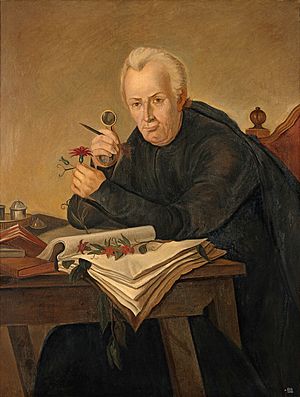Royal Botanical Expedition to New Granada facts for kids
The Royal Botanical Expedition to New Granada (in Spanish: Expedición Botánica al Virreinato de Nueva Granada) was a huge science project. It happened between 1783 and 1816 in the lands of New Granada. This area today includes Colombia, Ecuador, Panama, Venezuela, Peru, northern Brazil, and western Guyana.
The idea for this project was turned down twice. But in 1783, King Charles III of Spain finally said yes. The expedition was led by José Celestino Mutis. He was a Spanish priest, but also a smart botanist, mathematician, and teacher.
Contents
How the Expedition Started
Before the King approved the expedition, Mutis had already suggested it two times. He tried in 1763 and again in 1764, but no one listened.
Years later, Mutis moved to live in Mariquita. There, he met Archbishop and Viceroy Antonio Caballero y Góngora. The Viceroy helped Mutis by suggesting the idea to the King a third time. This time, the King agreed! He named Mutis the main botanist and astronomer for the expedition.
Getting Ready for the Journey
Even after his first ideas were turned down, Mutis kept in touch with scientists in Europe. One of them was Carl Linnaeus, a famous botanist.
When people heard the expedition was finally happening, scientists in Europe got very excited. In 1784, Mutis became a member of the Royal Swedish Academy of Sciences. He also joined the Royal Academy of Medicine. Botanists in Europe were eager to hear about new plants from America.
Mutis had written a report called "Memorial Instructivo y Curioso de la Corte de Madrid." In it, he shared what he learned about how some plants in New Granada could be used as medicine. He also told the Spanish King about a special tea from Bogotá. He thought this tea could be a good product to trade.
The Expedition's Journey and Discoveries
The expedition officially began on April 29, 1783. The team included many talented people. There were botanists Eloy Valenzuela and Fray Diego García. Geographers Bruno Landete and Jose Camblor were also part of the group. Painters like Pablo Antonio Garcia and Francisco Javier Matiz helped too. Other members included Salvador Rizo Blanco, collectors, and a messenger.
In 1790, the team moved to Santafe de Bogotá (Bogotá). They continued their exploration work there until 1816. Mutis brought in new members to the team. These included botanist Francisco Antonio Zea and his nephew Sinforoso Mutis. Geographer Francisco José de Caldas and chemist Jorge Tadeo Lozano also joined. José Antonio Candamo was hired to take care of the plant collection.
In Santa Fe, Mutis started a free public School of Drawing. He also began classifying the plants of New Granada. He followed the system created by Linnaeus. The King had asked Mutis to write a book called Flora de Bogota. Mutis also built an Astronomical Observatory. This was considered the first important science center in Colombia.
The expedition sent out smaller groups to explore more areas. One group was led by Francisco José de Caldas. He explored parts of what is now Ecuador for four years. He returned to Santa Fe in 1808 with a very large collection of dried plants. Another member, Fray Diego Garcia, explored the Upper Magdalena Valley. He collected many animal and rock samples. Eloy Valenzuela, who was a deputy director, explored the Santander region.
In 1801, the famous explorer Alexander von Humboldt visited Mutis. Humboldt was on his own expedition in America. He stayed with Mutis for over two months. He was very impressed by Mutis's work and his amazing plant collection.
Mutis led the expedition for more than 25 years. During this time, they explored about 8,000 square kilometers. He used a very careful method. They collected plant samples in the field. They also wrote detailed descriptions of each plant. This included information about where the plant grew and how it could be used for medicine or industry. Mutis passed away on September 11, 1808. His nephew, Sinforoso, took over and led the expedition until 1816.
During the expedition, 6,000 new plant species were found and described. They created 6,717 drawings and 20,000 plates. These plates showed 2,738 different types of plants.
What Happened After the Expedition
All the drawings, maps, letters, notes, and writings were sent to Spain. Also, all the items from Mutis's museum were sent. This included over 24,000 dried plants. There were also 5,000 plant drawings made by his students. Plus, there was a collection of woods, shells, tree resins, minerals, and animal skins.
When these items arrived in Madrid, they were counted and sorted. Most of them ended up at the Royal Botanical Garden of Madrid. They have been kept there ever since. A small part of the collection was sent to the Real Academia de la Historia in 1889.
See also
 In Spanish: Real Expedición Botánica del Nuevo Reino de Granada para niños
In Spanish: Real Expedición Botánica del Nuevo Reino de Granada para niños


